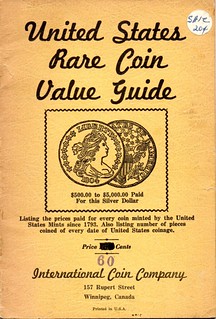
PREV ARTICLE
NEXT ARTICLE
FULL ISSUE
PREV FULL ISSUE
U.S. COIN BUYING GUIDE HISTORYRegarding last week's question about prices in a 1959/60 coin buying guide, Bill Eckberg writes: The prices for half cents and early large cents are at or below the 1947 Red Book values for coins in Good. If they are offering to buy any coin with a readable date at that price, prices in a guide book may or may not have much relevance. Ken Bressett writes:
Lee ran a print shop in Chicago and was a serious collector of United States coins. With the growing popularity of his monthly magazine he hit upon the idea of producing a companion product that would give collectors some idea of what coins were worth. That was a time when dealers were known to pay whatever prices they chose for coins, with no guidance or regard for fairness. The “Buying Guide” he devised gave some hint of what prevailing prices were throughout the country. Prices were incredibly low at that time when the country was just beginning to recover from the great depression. Even so there were dealers who paid only rock bottom prices to unsuspecting owners of old coins. The Hewitt book never bore his name as the source. It was a generic publication with a blank space on the front cover where any dealer could have his name and business address imprinted. I suspect that the ‘blank’ books were sold in bulk for around 10c each. They had a cover price of 50c to add to their respectability, although I think that dealers that used them simply gave them to potential customers. I found only a few of these old catalogs on my library shelf. The oldest was c. 1949 and has a blue cover, and yes, the price shown there for a Pine Tree 6d was $5.00. Yet, that was not unreasonably low when the retail value was only around $15. Another similar edition with brown cover was from c. 1952. Prices in this edition are somewhat higher for many coins, but not for the Pine Tree pieces. A third version from around 1962 has a different style cover showing a Lincoln Cent. This has much higher prices for just about everything, and the Massachusetts silver pieces are now priced at $12. Lee Hewitt and coin dealer Charles Green, were both prominent Chicago numismatists. It was with the help of these two men that R. S. Yeoman put together his now famous Handbook of U.S. Coins (the Blue Book). The names of these three men are on the cover of early editions as co-authors. Many if the illustrations in both the Hewitt booklets, and the Blue Book are the same, as are the general listings and organization. I have never been sure of which came first, but there was an obvious cooperation between these publications. Yeoman told me on several occasions that he began publishing the Blue Book with the intention showing realistic prices for U.S. coins without bias or any self-serving interest. His philosophy has served the publication and the hobby well for the past 70 years.
These Hewitt guides make for a challenging numismatic literature collectible. I had a number of different ones in my library at one point - different that is, based on the dealer name on the cover. It's a interesting snapshot of hobby history.
-Editor
To read the earlier E-Sylum article, see:
QUERY: 1959 COIN BUYING PRICES
(www.coinbooks.org/esylum_v16n06a14.html)
The Numismatic Bibliomania Society is a non-profit organization promoting numismatic literature. See our web site at coinbooks.org. To submit items for publication in The E-Sylum, write to the Editor at this address: whomren@gmail.com To subscribe go to: https://my.binhost.com/lists/listinfo/esylum All Rights Reserved. NBS Home Page Contact the NBS webmaster 
|
